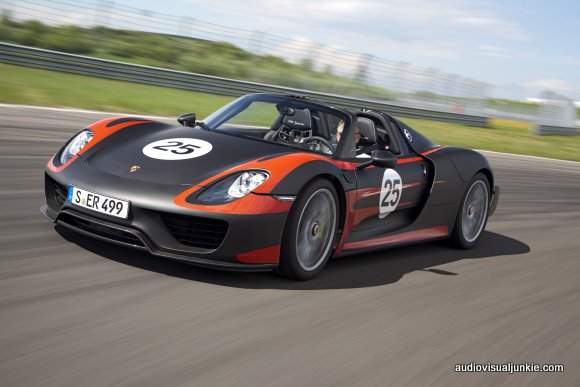On September 18, 2013, production began of the new Porsche 918 Spyder. Michelin will be the sole tire supplier for this new hybrid supercar, of which 918 units will be produced.
The MICHELIN Pilot Sport Cup 2 is built with the same tools for racing tires, and offers stability, sporty agility and grip that delivers optimal performance even in high temperatures, and harsh road conditions.
The following is a look at the figures, records and special features of the Porsche 918 Spyder and its tire partner the MICHELIN Pilot Sport Cup 2 :
9 figures
- 1 tire, the MICHELIN Pilot Sport Cup 2, certified for use around the world.
- 1 global tire supplier for the Porsche 918 Spyder:Michelin.
- 2 sizes:265/35-ZR20 for the front wheel and 325/30-ZR21 for the rear.
- 3,672 (918 x 4) very high performance Michelin tires will equip this supercar, of which 918 units will be manufactured.
- 887hp. The car’s horsepower, provided by a 608hp internal combustion engine and two electric motors that deliver 115 and 95 kW.
- 340 km/h. The car’s maximum speed.
- 3.3 liters/100km. The fuel consumption for this premium sports model.
- 79 of CO2/km. The level of carbon emissions, thanks to the model’s hybrid powertrain.
- 1,280 Nm.The torque that the Michelin tires transmit to the ground when the car accelerates.
1 record
6.57 minutes.The record time posted by the Porsche 918 Spyder, fitted with MICHELIN Pilot Sport Cup 2 tires, for 1 lap on the celebrated Nürburgring circuit, a total of 20.832 km, or 417 seconds of “extreme grip.”
8 key messages about the technologies integrated in the record-setting MICHELIN Pilot Sport Cup 2 tire
A highly rigorous development program
- 50 evaluations carried out during the certification process.
- 150 hours of tests on 5 circuits in Europe:The MICHELIN Research and Technology Center in Ladoux, France, the Nürburgring (Nordschleife) circuit in Germany, the Nardo circuit in Italy, the Idiada circuit in Spain and Contidrom in Germany.
- 4,000 km driven on the Nürburgring circuit.
- 550 prototype tires tested – 200 special series tires – 400 pre-series tires.
A co-development partnership dating back more than half a century
- 1 tire manufacturer chosen by Porsche.
- 10 years since the beginning of the cooperation project between Porsche and Michelin for the development of special tires for supercars. The partnership began with the Carrera GT in 2003, although the French tire maker and the German car manufacturer have worked together since 1961 on all models in the range.
A major achievement:delivering superior performance in three conflicting areas
Performance on dry surfaces (especially on the track), energy efficiency and safety on wet roads were the demands made by Porsche when developing tires for the 918 Spyder.In short, the performance required from Michelin’s tires perfectly reflects the features of the supercar, which, with its dual thermal and electric powertrain, combines sportiness and lower fuel consumption.
The new MICHELIN Pilot Sport Cup 2 tires developed for the Porsche 918 Spyder deliver outstanding performance in terms of sporty driving and energy efficiency, which results in less rolling resistance and enhanced safety on wet surfaces.
Used at very high speeds and on the track, the MICHELIN Pilot Sport Cup 2 must offer stability (meaning front/rear balance), sportiness (response time and agility), grip (for speed) and a rubber compound that performs well at high temperatures (enabling consistent performance, lap after lap).
To improve safety, the tire’s handling on wet surfaces was of course reworked.As a result, the new MICHELIN Pilot Sport Cup 2 provides stability, balance and grip on wet roads as well as improved resistance to aquaplaning, both lateral (when cornering) and longitudinal (caused by engine torque).
The new MICHELIN Pilot Sport Cup 2 is characterized by: Its tread rubber compound
Produced with the same tools used to manufacture racing tires, the tread compound for the MICHELIN Pilot Sport Cup 2 integrates Bi-Compound technology, which involves the use of different rubber compounds on the inside and outside of the tread.The outer rubber is made with a high molecular weight elastomer whose hardness has been specially designed to deliver maximum adherence and outstanding dry grip on curves, especially on tight corners,while the inner side of the tire uses rubber made with a more rigid elastomer to ensure precision steering.
An aramid fiber belt
The main feature of the belt made with aramid, a high-tenacity fiber, is its heightened tensile strength.This composite is both light and highly resistant;in fact, it is five times more resistant than steel at equivalent weight.Positioned on the crown under the tread, the strip rubber is applied with variable tension between the shoulders and the center of the tire.It is tightened so firmly that it literally locks the tire structure into a practically inelastic belt.As a result, the tire’s shape is effectively preserved and its footprint remains constant, even at very high speeds.
The Track Variable Contact Patch 3.0®
This innovation is adapted from Variable Contact Patch 2.0 technology integrated in the MICHELIN Pilot Super Sport tire. It optimizes pressure in the tire’s contact patch so the same amount of rubber is always in contact with the track, whether driving in a straight line or cornering, even sharply.
A new bead region
The bead region is 10% wider than that of a traditional sports tire.It is strengthened with a high modulus rubber compound that increases the tire’s lateral stiffness and delivers sporty responsiveness as well as precision steering.
“Velvet” sidewalls
A special tooling process in the molds combined with the Group’s unique expertise has led to the development of MICHELIN Velvet Technology®. This solution has made it possible to create contrast and shades of black giving a velvet look to certain sections of the outer sidewall using micro-geometry techniques that absorb light.
